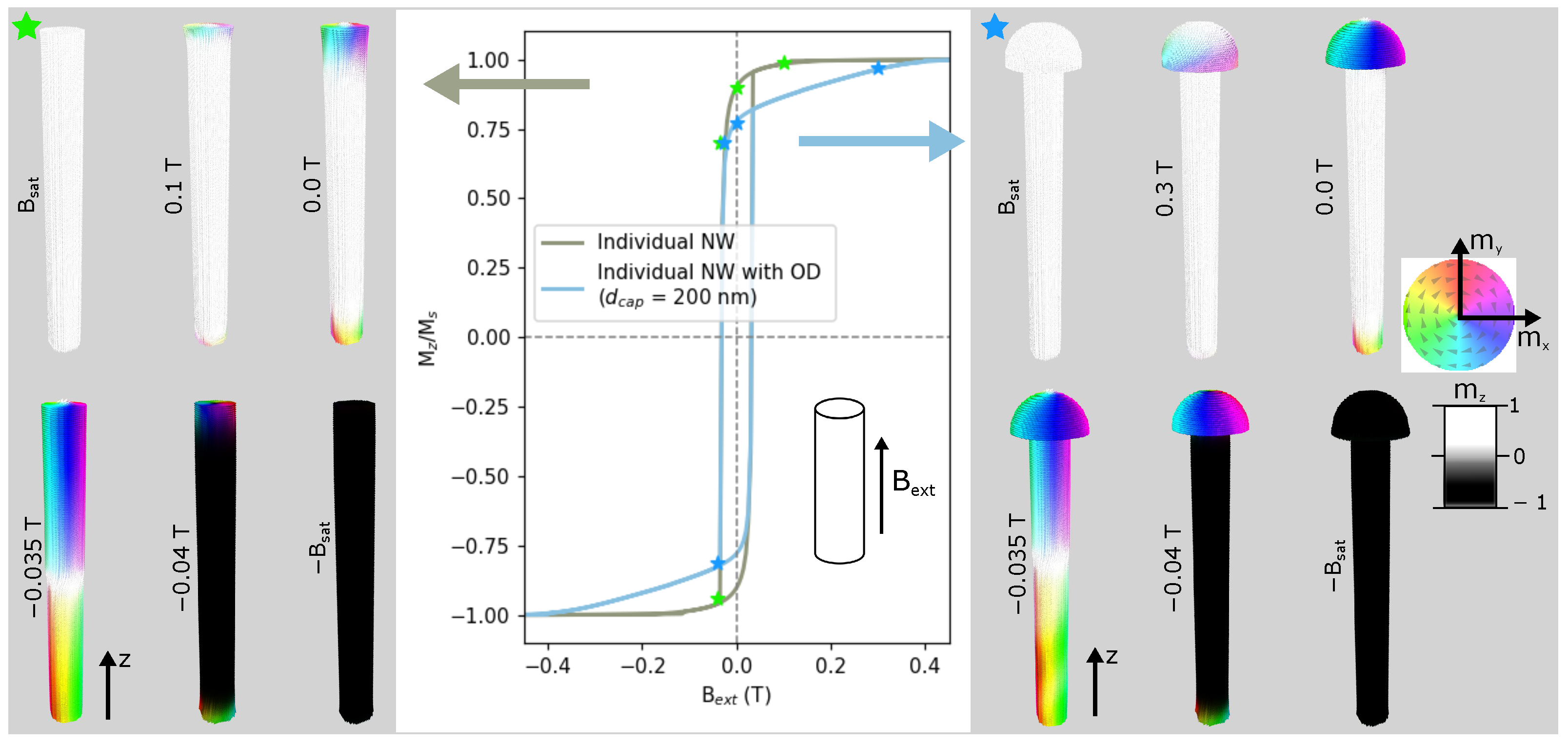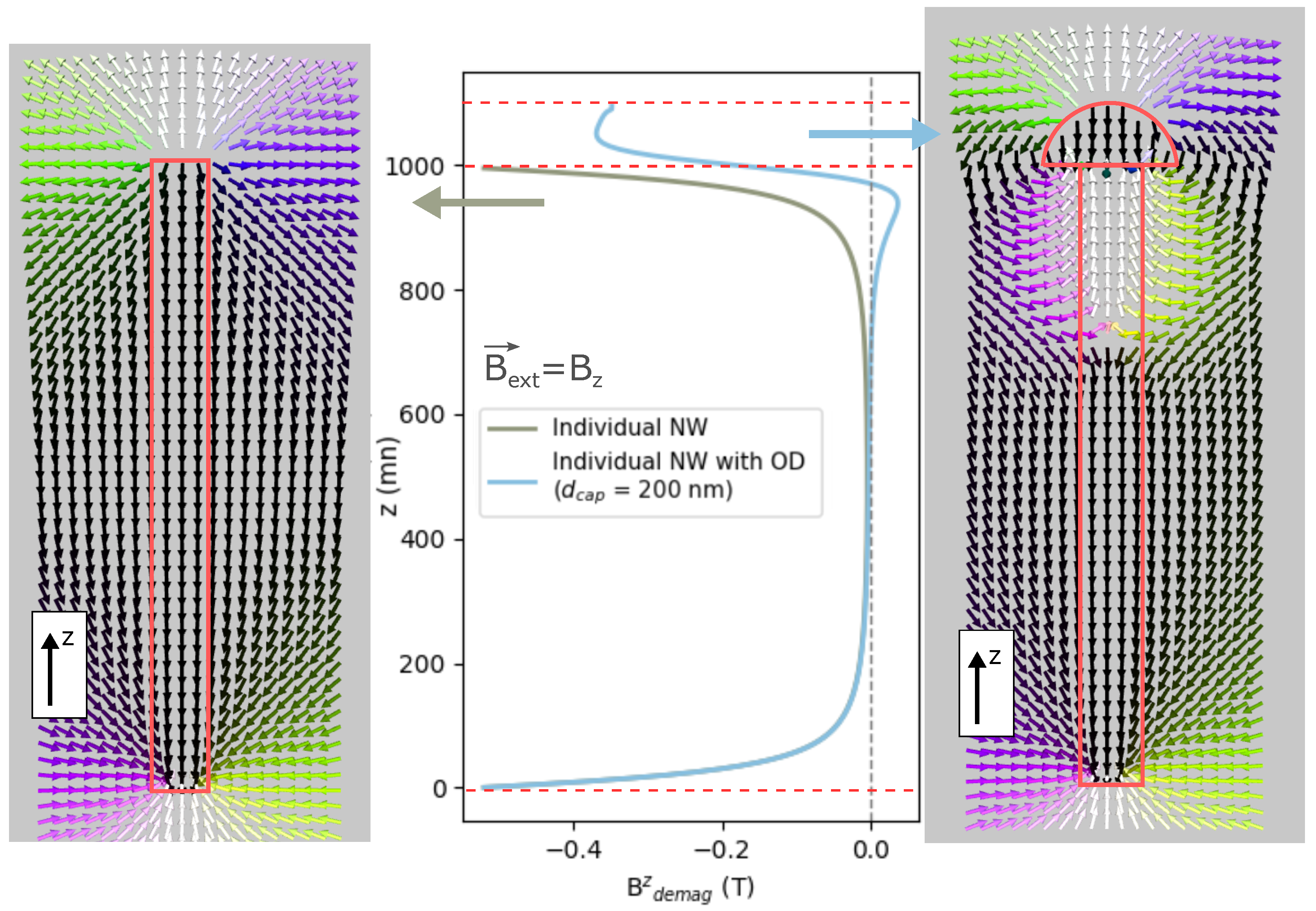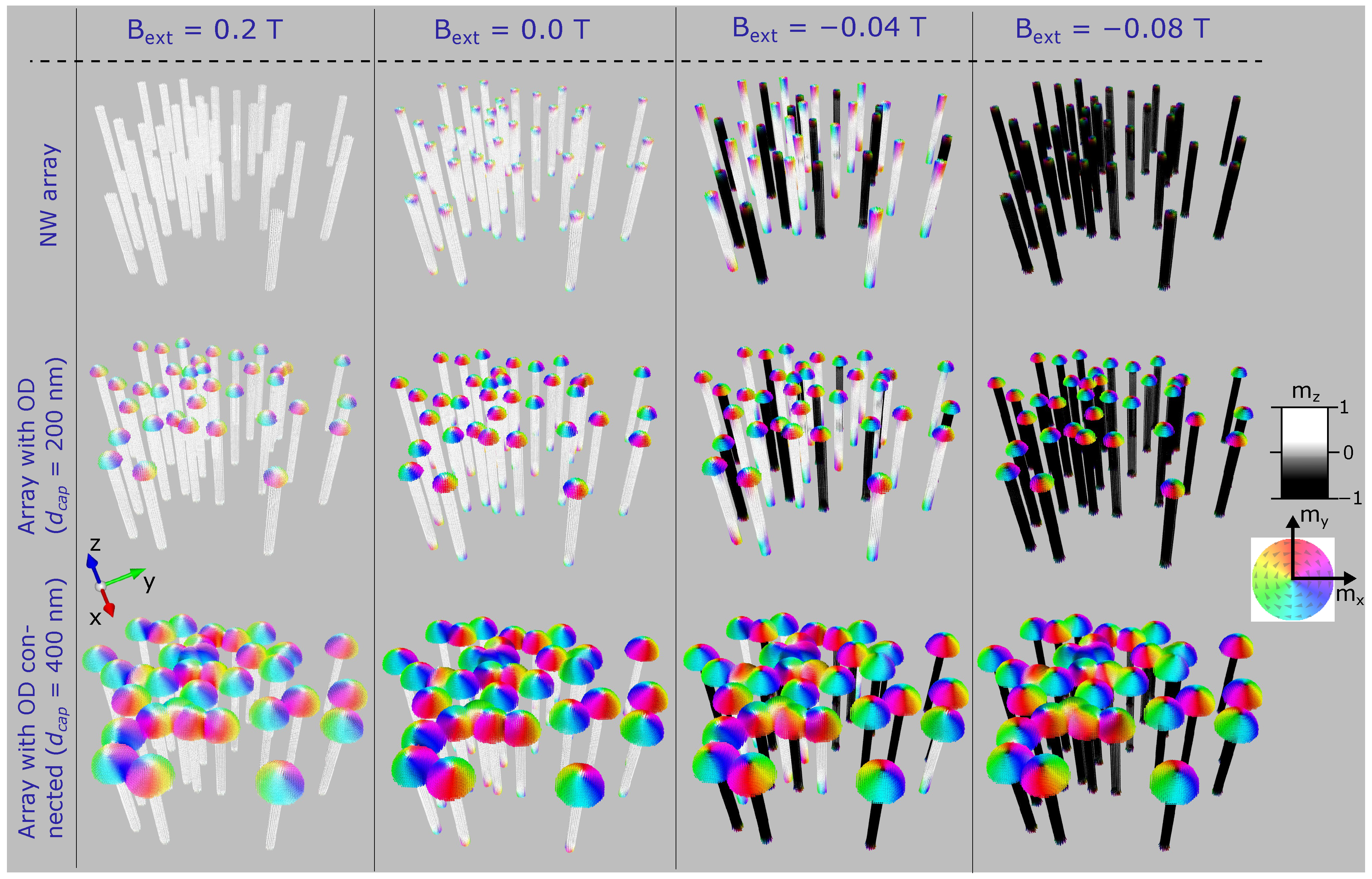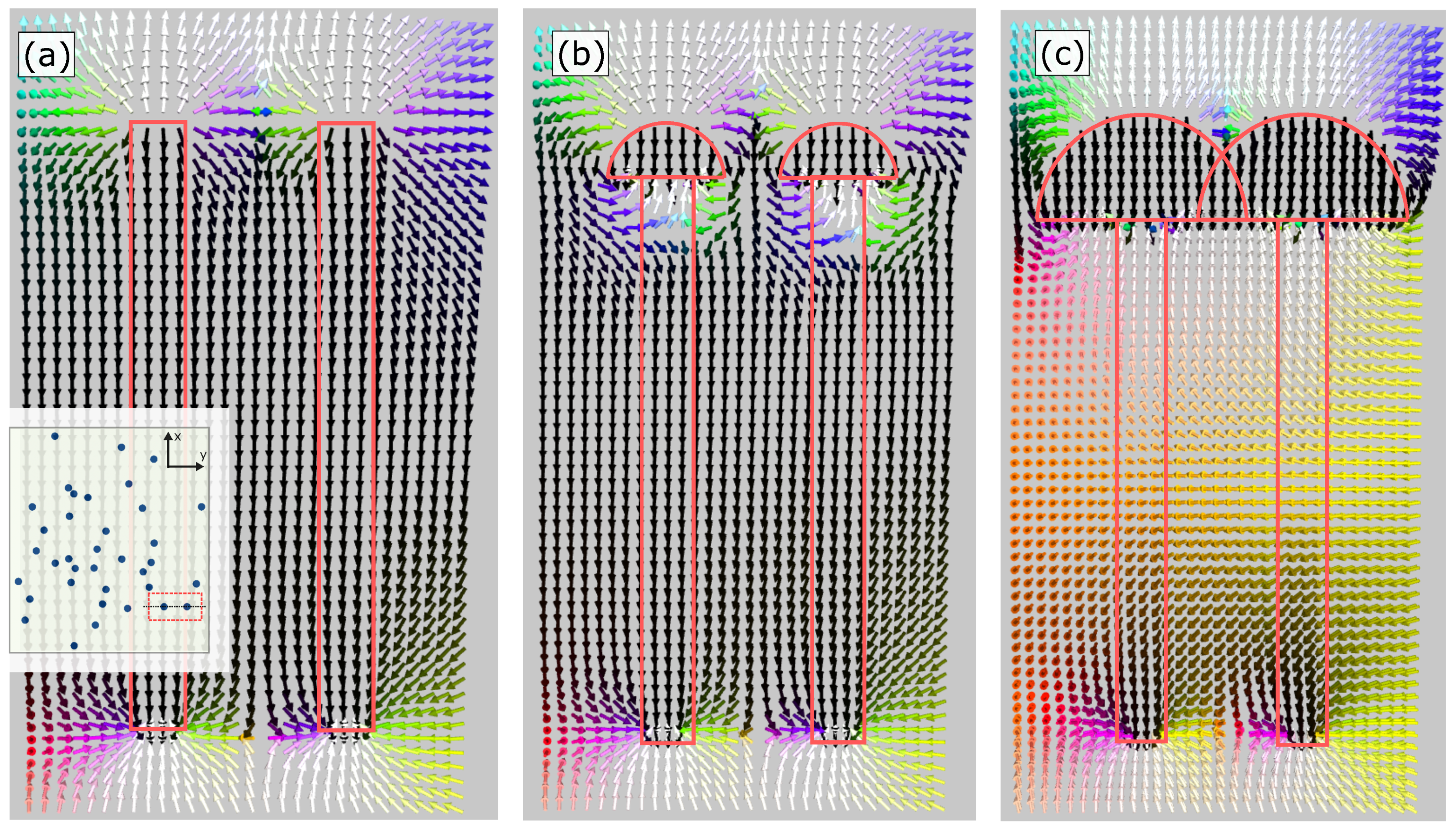3.1. Individual Nanowire
On the first step of the study, the magnetic behavior of an individual nanowire was considered. To investigate how the overdeposition may affect the magnetic properties of such a nanowire, the calculation of the hysteresis loop was done for the external field applied along the long axis of the nanowire (i.e., along the z-axis (Bext = Bz).
Figure 3 shows easy axis loops for a single nanowire with and without OD and corresponding representations of the magnetic configuration during the reversal. Let us first consider NW without an overdeposition cap. As expected for such a diameter of Py nanowire [
20], the magnetization reversal process appears via the vortex domain wall (DW) propagation. Namely, two vortices of opposite chirality are formed at each end (as seen for zero-field magnetization state in
Figure 3) and propagate toward each other, leading to magnetization switching (along the
-axis) of the whole nanowire. A bit different magnetization reversal scenario observed for the nanowire with OD. The vortex is formed at the hemisphere more initially than for the regular nanowire (at field B
ext ≈ 0.3 T), while the rest of the nanowire’s volume remains saturated with the external field (i.e., along
z-axis). As seen from the corresponding hysteresis curve, this leads to a decrease in magnetization with the applied field and results in the less squared curve. At the remanence (B
ext = 0 T), the vortex of opposite chirality is formed at the opposite end of the NW. Eventually, the magnetization reversal of NW occurs by a process similar to the regular nanowire (vortex DW propagation) at the same switching field, B
ext = −0.035 T.
As can be seen, the appearance of a hemispherical cap on the top of the individual NW does not strongly affect the hysteresis loop: there is a small reduction in the squareness (at about 15%) with no change in coercive field. Such behaviour aligns with previous studies of nanowires with different geometries (e.g., with spherical or conical ends, dumbbell- or diablo-like tips) which showed a visible reduction of remanence compared to nanowires with a cylindrical shape [
17,
27]. However, in that case, much pronounced changes in coercivity were observed, probably due to the more complex geometry of the nanowires, leading to a stronger change in shape anisotropy. On the other hand, the magnetic behavior of NW with OD reminds the behavior of nanowires with diameter modulations [
28], for which the decrease in hysteresis squareness was also observed. Similarly to our case, where the vortex was initially formed on the hemisphere (see
Figure 3 for NW with OD at B
ext = 0.3 T), in this case, the magnetization reversal process also starts in the segments of the larger diameter compared to the rest of the nanowire.
As it is known, the total magnetic field of the structure consists of an applied external field and a demagnetizing field. The latter is strongly dependent on the shape and orientation of the magnetic object and may directly influence the magnetic behavior.
Figure 4 presents the demagnetizing field distribution and profile of its z-component along the nanowire for the case of an individual NW with and without OD at the saturating magnetic field. For an isolated nanowire without OD, the demagnetizing field is high at the tips of the nanowire, where magnetic charge densities are localized, and is close to zero in the central part of the nanowire, where they are compensated. From the visualization of the demagnetization field distribution, it is seen that the field looks like that of a magnetic dipole (lines leaving the “north” pole and entering the “south” pole of the NW). The symmetry of both ends and their far position is important for holding the saturated state and relatively hard reversal of the magnetization. Therefore, the corresponding hysteresis loop is of high squareness and low coercivity.
For the NW with OD, the demagnetizing field is also close to zero at the central part and rises at the NW ends. Importantly, as seen in
Figure 4, the
has a high value over the entire region of the hemispherical cap (i.e., between z = 1000–1100 nm), which is explained by the high demagnetizing factor of such geometry [
29]: for a hemisphere magnetized along its symmetry axis (the vertical axis passing through the flat circular face), the average demagnetizing factor equals to approx. 0.5. For a long cylinder (aspect ratio ≥ 10) magnetized along its axis, in contrast, the demagnetizing factor equals approx. 0.04. Similarly, the higher value of demagnetizing field on the distorted tips of NWs (diabolo and dumbbell shapes) in comparison to a regular NW was observed in previous studies [
27]. As seen from the map of demagnetizing field distribution, the demagnetizing field possesses a complex profile at the joint between the cap and the cylindrical part of the nanowire. In contrast to a flat-end cylinder, instead of going directly to the opposite pole, many field lines bend back toward the cylindrical sidewall near the junction. This creates a highly non-uniform demagnetizing field – local closed-loop flux patterns appear near the junction instead of simple pole-to-pole connections. As a result, in this region,
points along the external field, and therefore, in
Figure 4, the blue curve has a local region where the demagnetizing field is positive. For such a nanowire, with one end having the magnetization perpendicular to the long axis, the system tends to minimize the stray magnetic field arising from the surface magnetization. Therefore, a vortex state is formed at the NW’s top at a higher field (i.e., B
ext ≈ 0.3 T) in comparison to the nanowire without OD, for which vortices appear simultaneously at both ends at B
ext ≈ 0.1 T. In such a way, the presence of the semi-spherical texture on the nanowire is responsible for a visible change in the hysteresis loop, namely, a reduction of squareness and a much higher value of saturation field.
3.2. Array of Nanowires
In the next step of the study, we will examine the magnetic behavior of the arrays of nanowires. Here, it is important to note that according to the literature, the overdeposition process can occur in different stages [
13,
14]. Normally growth of nanowires in the membrane proceeds until the pores are filled up to its top surface. However, the extension of the electrodeposition process even for a few seconds results in the formation of caps on the membrane surface. If such a process continues, the caps will grow and even connect to each other as the coalescence on the membrane surface occurs. Therefore, in this section, we will consider three different magnetic structures, namely, an array of nanowires without OD (see
Figure 2a), an array of nanowires with hemispherical caps formed on the top (see
Figure 2b), and an array of nanowires with overdeposition caps, part of which are connected to each other (see
Figure 2c).
Figure 5a shows hysteresis loops of the above-mentioned arrays of nanowires with a magnetic field applied along the nanowires’ long axis (i.e., along the
z-axis). As we can see, each of the three samples exhibits a hysteresis loop that is nearly rectangular, as expected for the nanowires with the arrangement corresponding to the PC membrane. This indicates that the dipolar interactions between the nanowires are significantly smaller than, for example, in the case of hexagonal packing [
30], corresponding to the AAO matrix. Nevertheless, a significant difference is observed between the arrays with and without overdeposition. Namely, the strong reduction of squareness from 0.88 for NWs without OD to 0.77 for NWs with hemispherical caps and 0.36 for NWs with connected caps. Also, the saturation of magnetization is reached for a larger field with the increasing effect of overdeposition in the array. Looking at the magnetization curves for a field applied perpendicular to the NWs long axis (
Figure 5b), we can see that there is not much difference between the array of NWs with and without OD caps. For both cases, a typical for NW (with aspect ratio ≥10) hard-axis hysteresis loop is observed [
31]. However, when the OD caps are connected, the NWs array shows completely different behavior. The corresponding hysteresis loop shows visible coercivity and non-zero squareness, indicating that the easy axis of magnetization is no longer positioned strictly along the NW long axis, but changes toward the in-plane position for a certain amount.
A better understanding of the magnetization switching of NW arrays can be obtained by examining the magnetization distribution during the reversal process (
Figure 6). For the case of nanowires wihout overdeposition, the magnetization reversal proceeds through the following sequence: the formation of the vortices on the NW tips (see configuration for B
ext = 0.0 T), switching of individual nanowires along the applied field as it becomes negative (see configuration for B
ext = −0.04 T) and finally, switching of the entire array along the
-axis (see configuration for B
ext = −0.08 T). In contrast, for arrays with overdeposition, the initial stages of magnetization reversal are characterized by vortex formation exclusively at the capped tips, similar to the behavior of an isolated nanowire. These modified tips serve as nucleation points for magnetization reversal, resulting in a non-uniform magnetization distribution along the nanowires. As a result, as one can see on the corresponding hysteresis loop (
Figure 5), the magnetization decreases more rapidly with the applied field. At the remanent state (B
ext = 0.0 T), the vortices are observed at both ends of the nanowires and subsequently propagate toward the center of the nanowire with further decreasing of the field. In contrast to an individual nanowire, for the array, the vortex domain walls do not reach the center of the NW, and its central part remains in the longitudinal orientation of magnetic moments. This is probably due to the influence of the dipolar field from the neighboring nanowires [
30,
32]. A similar magnetization reversal process is observed for an array with connected OD caps; however, there is even more initial vortex formation (at B
ext ≈ 0.5 T) and, as a result, an abrupt decline of the magnetization curve with applied field, compared to the other two cases. Important to note that a closer look at the magnetization configuration of the array with connected OD caps for the B
ext = 0.0 T, reminds the configuration of the double or triple vortex states with opposite vortex chiralities [
33]. The dynamics of such multivortex states can be very complex, and the ability of their stabilization and control is of great interest for nanotechnology [
34].
It is well established that the magnetic behavior of nanowires is primarily governed by their shape anisotropy [
35,
36] (in the case of permalloy, the magnetocrystalline anisotropy is negligible compared to shape effects). For arrays of nanowires, dipolar interactions between neighboring wires can also significantly influence the overall magnetic anisotropy [
37]. While these interactions are relatively weak in randomly distributed nanowires, the formation of hemispherical caps during overdeposition, and especially their mutual connection, can substantially modify the dipolar coupling. Consequently, both shape-related factors and interwire interactions play key roles in determining the evolution of the magnetic properties of nanowires with increasing overdeposition. To analyze this effect in more detail, the distribution of the demagnetizing field inside and outside the nanowire arrays was examined.
Figure 7 shows profiles of the
z-component of the demagnetizing field along the
z-axis of a selected nanowire of the array. For the case of NW without overdeposition, the demagnetizing field exhibits a symmetric profile, with maxima localized at the wire ends and a gradual decay toward the central region. This distribution reflects the shape anisotropy of an elongated cylinder, where strong stray fields develop mainly at the ends. In contrast, for nanowires with overdeposition, the demagnetizing field is strongly modified near the capped ends. The overdeposited regions act as sources of enhanced stray fields, which, as follows from
Figure 7, lead to a more inhomogeneous axial profile. Specifically, the field intensity is significantly larger at the capped ends compared to the uncapped regions, thereby facilitating more initial vortex nucleation as was observed from magnetization maps (
Figure 6) and a much faster decrease in magnetization with the applied field as seen from the hysteresis loop (
Figure 5).
Let us take a look at the demagnetizing field distributions along the long axis (i.e., along the
z-axis) of the two selected nanowires in the array (NWs are at magnetization saturation along the OZ direction). As can be seen from
Figure 8, for the case of NWs without OD, the demagnetizing field distribution is changing mostly along the
z-axis, similarly to an individual cylinder: field lines emerge radially outward from one nanowire tip, extend along the axial direction, and terminate at the opposite tip. In contrast, for nanowires with overdeposition, the topology of the field lines is modified near the capped ends: part of the field closes locally beneath the cap region. This localized closure of field lines leads to a partial confinement of the demagnetizing field within the overdeposited volume. A similar situation takes place for the NWs array, for which the caps connect to each other. However, as can be seen from
Figure 8, much complicated distribution is observed, accompanied by a much pronounced appearance of
x- and
y-components of the demagnetizing field. Such redistribution of field lines related to the increased interaction between neighbouring nanowires: it enhances short-range dipolar interactions between them, especially at the ends where the overdeposited caps face each other (see corresponding profile for NWs with connected caps in
Figure 7). In particular, the capped ends act as localized sources of stray fields that overlap more strongly with adjacent elements, thereby strengthening the inter-wire interactions and promoting distinct magnetic behavior, namely advancing a slight in-plane alignment of the magnetic easy axis (see
Figure 5).
3.3. Summary of Simulations and Relation to the Experimental Data
Overall, by considering the effect of overdeposition in both individual nanowires and arrays, we can see that it has a pronounced influence on their magnetic behavior. A summary of the corresponding magnetic parameters change is presented in
Figure 9. As we can see, the hysteresis loop calculations reveal a similar trend for all investigated systems when overdeposition is considered: a reduction in squareness accompanied by an increase in the saturation field (field at which material is fully magnetized), but with no significant effect on the coercive field. This behavior can be explained by the geometric modification of the nanowires caused by overdeposition, which directly alters the shape anisotropy. The analysis of the magnetization reversal process and demagnetizing field distribution provides further insight into these changes. As shown, the overdeposition caps at the end of the nanowires act as nucleation sites, promoting the formation of vortices. This arises from the enhanced demagnetizing field in these regions: the OD caps generate a complex demagnetizing field profile, leading to a locally confined increase in the field. As seen in
Figure 9b, the z-component of the demagnetizing field increases in both isolated nanowires and arrays when OD is present. Importantly, in the case of arrays, the in-plane component of the demagnetizing field also becomes significant, particularly for strong overdeposition, where coupling between OD caps of neighboring wires occurs. Consequently, mutual demagnetizing fields modify the effective anisotropy by reducing the axial preference (along the wire axis) and promoting collective magnetic states. This effect also alters the interaction energy between neighboring nanowires. As seen in
Figure 9b, the magnetostatic energy in nanowire arrays is relatively weak in the absence of OD, but increases substantially once OD is introduced.
An intriguing aspect revealed by the simulations of nanowire arrays with overdeposition effects concerns the role of the increased cap size on the magnetic behavior and its relation to the physical connection between neighboring nanowires. In the present study, we analyzed two representative cases: an array with OD caps of diameter
= 200 nm, corresponding to separated NWs, and another with
= 400 nm, where adjacent nanowires become physically connected through their caps. The results indicate that increasing the OD cap diameter leads to a marked reduction in the squareness of the M
z/M
s hysteresis loop (when the magnetic field is applied along the nanowire axis,
z-direction). However, in addition, for the case of interconnected nanowires, a narrow hysteresis loop emerges for the field applied perpendicular to the nanowire axis (
x-direction), as shown in
Figure 5b. This behavior can be attributed to the formation of a continuous, ferromagnetic layer on top of the NW array once the OD caps merge. Such a layer introduces an additional in-plane magnetic anisotropy in the system, which results in the observed hysteresis in the M
x/M
s curve. Hence, the physical connection between OD caps appears to be the dominant factor responsible for the emergence of this in-plane magnetic component, which is consistent with previous experimental observations [
38].
To further test this hypothesis, we carried out additional simulations focusing on individual nanowires, thereby excluding the inter-wire connection effects. Four configurations were considered: (1) a NW without OD, (2) a NW with
= 200 nm, (3) a NW with
= 300 nm, and (4) a NW with
= 400 nm. The obtained results (see
Figure S1 of Supplementary Materials) reveal that increasing the OD cap diameter progressively reduces the squareness of the M
z/M
s hysteresis loop for the field applied along the nanowire axis. However, no hysteresis is observed for M
x/M
s in any of these cases, confirming the absence of in-plane anisotropy in isolated nanowires even for large OD caps.
Concerning the array of nanowires, which imitates the arrangement corresponding to a polycarbonate membrane, the NWs are not located at the same distance from one another (see
Figure 1a). Consequently, the influence of the OD cap physical connection varies across the array, leading to nonuniform magnetic interactions. This implies that the two effects (the intrinsic modification of individual NW magnetic behavior due to OD growth and the extrinsic coupling between physically connected caps) cannot be fully separated for the array of nanowires. To better capture this transition, we also simulated an intermediate case with
= 300 nm (see
Figure S2 of Supplementary Materials). In this case, approximately half of the nanowires become connected through their OD caps, forming partial bridge-like regions that resemble a ferromagnetic layer. As a result, a visible coercivity appears in the M
x/M
s hysteresis loop, thereby confirming that the physical connection between OD caps promotes the emergence of in-plane magnetic anisotropy within the system.
Important to note that numerous studies report the appearance of overdeposition in the process of synthesis of nanowires [
13,
14,
15,
16,
24], however, the study of its influence on the magnetic properties is poorly presented. Our research therefore, provides a valuable analysis of the impact of OD on the magnetic behavior of nanowire arrays, including hysteretic response, magnetization reversal mechanisms, and demagnetizing field distributions. Nevertheless, the presented calculations can also be qualitatively compared with experimental observations. For example, studies of Co nanowires with diameters of 50 nm and Co/Cu multilayer nanowires with diameters of 200 nm, electrodeposited in polycarbonate membranes, have reported a strong influence of OD on the magnetic properties [
11,
38]. In particular, this effect is primarily reflected in the pronounced change in the easy axis of magnetization of nanowires and the emergence of an in-plane orientation of the magnetic easy axis. Our calculations are consistent with these observations. Specifically, for nanowire arrays with connected OD caps, the in-plane magnetization curve exhibits a clear hysteresis, and the x-component of the demagnetizing field becomes non-negligible. These results confirm that OD has a strong effect on the magnetic properties of nanowires, and is especially important when neighboring wires are connected through OD caps.














